| 1 | Ultra-thick rhino skin |
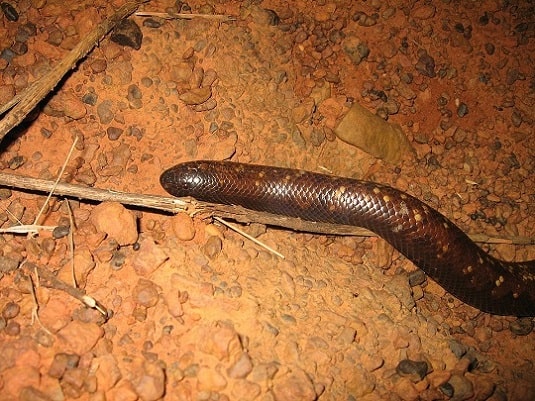
The Calabar burrowing python (Calabaria reinhardtii) is a harmless, non-venomous constrictor native to central and western Africa. They measure 1-1.5 metres and feed primarily on small, scurrying mammals like rats. They tend to inhabit forests, rather than farmland or people’s backyards. Overall, Calabar burrowing pythons are completely inoffensive, but there’s one area where they demolish their snake neighbours in Africa: the sheer toughness of their skin.
A 2016 study compared this docile species to 13 other snakes, including garter snakes and rattlesnakes. Skin samples (not live snakes) were turned into colour-stained cross sections and examined under a microscope. The scientists discovered an incredibly tightly organised structure of collagen fibres, far denser than the simple collagen of a garter snake.
Individual collagen fibres ran in perpendicular patterns to the fibers adjacent, in a complex structure comparable to a rhino’s skin. The researchers themselves dubbed the species “the rhino among serpents”. Overall, the Calabar burrowing python’s skin was 15 times thicker than the next snake tested.
Despite this armour, Calabar burrowing pythons are completely unrestricted in their movements. They’re just as flexible as any other snake, just extremely difficult to penetrate with sharp fangs or piercing claws. Glove manufacturers are now interested in this African snake’s skin, hoping to make thick, cosy gloves which don’t restrict the wearer’s movements.
| 2 | No close relatives |
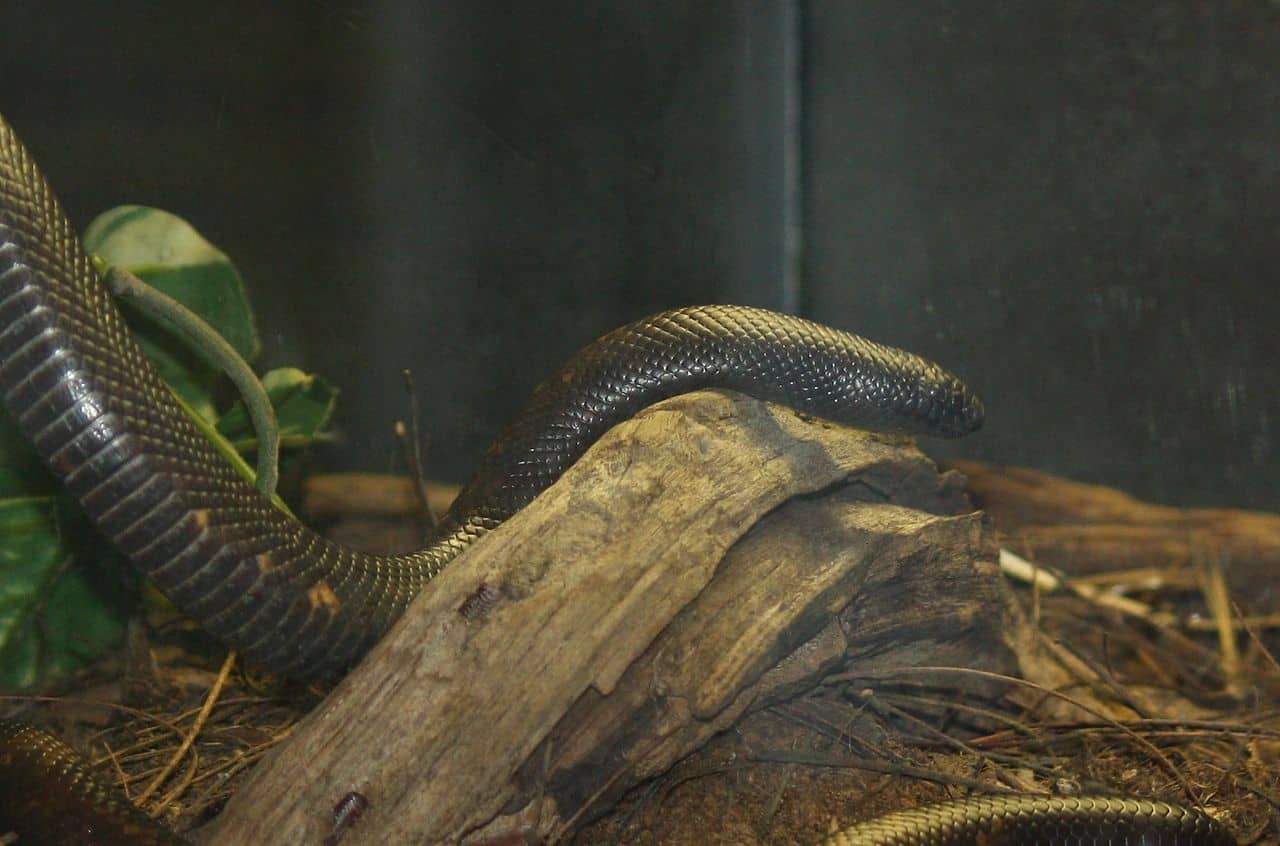
The Calabar burrowing python is unusual in many ways, as it’s completely isolated on the tree of evolution. It’s the sole member of its genus (Calabaria), with no close living relatives. There’s been a furious debate for years over whether it’s really a python, and these days it’s classed as a boa, albeit a highly unusual one.
In 1993, it was moved to the Charina family, which includes the rubber boas of the USA, but this didn’t last long, as people wondered why the sole 3 surviving members of a family would live in central Africa and then California. Some believe they’re related to the Madagascan boas, while others theorise a link to the shieldtail snakes (Rhinophis) of India and Sri Lanka.
All the physical signs suggest that this is an ancient, primitive lineage. Calabar burrowing pythons have a very poor ability to gape their mouth widely to swallow prey, and this was one of the earliest features to develop in snakes, which made them what they are. For example, the extinct snake Sanajeh indicus discovered in 2010 had only just began to unhinge its jaws, and the fossils dated back 67.5 million years. The Calabar python’s evolutionary branch may have split off tens of millions of years ago, possibly even back to the dying embers of the dinosaur era.
Since then, it’s been a long and lonely road ahead. 10 million years ago, Calabaria reinhardtii may have had 10-15 relatives, but it’s now the last one standing.
| 3 | Nearly always found in forests |
Calabar burrowing pythons look more like giant blind snakes than any living boa, and like that family, they’re a heavy underground dweller. A 2002 Nigerian study investigated 400 C. reinhardtii habitats during the wet season, and concluded that 80% of their time was spent underground. This was mostly close to the surface, rather than in deep underground chambers.
The Calabar burrowing python prefers forests by far, including dark forests, swampy forests, and forest clearings. They appear in cultivated land sometimes, but stay far away from suburbia. Despite a huge range in Africa, from Equatorial Guinea to Nigeria to DRC, this snake is far less commonly encountered than its neighbour the ball python. They’re nocturnal, and only prowl above ground during the darkest hours.
Calabar burrowing pythons love to hide out in termite mounds, particularly during dry season. They might be burrowers, but they also move upwards, into small bushes 1 metre above ground. They climb logs sometimes, and are common in mulchy forests with a thick coating of leaves.
| 4 | Preys mainly on newborn mice |
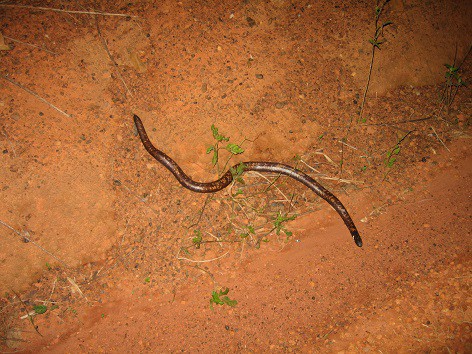
The Calabar burrowing python has been dubbed a “baby eater”, because of its unusual preference for younglings of mammals. A Nigerian study found a dietary makeup of 80% rodents, and their plan (or animal instinct anyway) is an unusual one: invade their burrows at night.
After finding a dark opening, C. reinhardtii slithers downwards, following the tunnels carved out by others. They keep investigating, until they finally find the underground resting chamber. Then they scoop up baby mice as they sleep, totally ignoring the adults.
Technically, the Calabar burrowing python is a constrictor, but they’re unable to squeeze prey in the centre of their coils. Instead, in what may be another evolutionary relic, they pin their prey as hard as possible against the subterranean walls. They can even store a second struggling prey in their coils while pressing the first one. This system is the same in captivity, always pressing prey against the sides of containers, even when there’s no actual need for it. They’re in a terrarium, not a burrow, yet they still have their wild instincts.
| 5 | Diet/tough skin – a connection? |
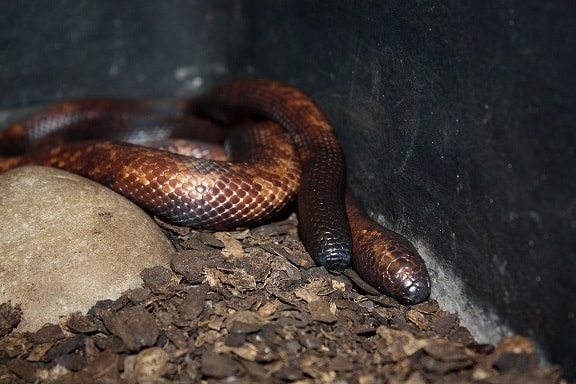
Calabar burrowing pythons are sometimes particularly sneaky, and wait for adults to leave their burrows before invading. With their small mouths, they need to gobble up multiple mice newborns at once. They’re the opposite of a death adder, enjoying many regular small meals rather than occasional massive ones.
It’s theorised that the Calabar burrowing python’s raiding strategy is why the legendary thick skin evolved. Snakes have endless coils, but they’re not gods. As they constrict the babies, they’re completely exposed to the furious defensive parents, which will unleash havoc on their backs. Mice bites can be nasty, and this agony could have forced the snake to retreat, costing them a meal. It’s possible that the thick skin developed in response to defensive adults, becoming more and more rhino-like and gradually making them ultra-specialised predators. It’s like the chicken and the egg debate, and in this case, the burrow raiding came first.
The Nigerian study also discovered their top prey species: Temminck’s mouse (Mus musculoides), a very small orange-tinged species. Their prey also includes rattus rattus (the black rat) and shrews.
| 6 | Gigantic snowballs of eggs |
Calabar pythons lay particularly massive eggs. There’s normally only 1-5, but each looks like a giant white snowball. Meanwhile, a blood python lays up to 30 much smaller eggs, and a Burmese python can hit 80.
A Calabar python’s eggs can represent 50% of a female’s body weight, and in the days before giving birth, her body becomes grossly distended. Pictures of the eggs resemble a snake toy surrounded by massive white Christmas decorations. However, the hatchlings themselves aren’t particularly huge, just 40-50% of the egg weight. The eggs are packed with a particularly high amount of water or nourishing nutrients.
Another fact is that the eggs must be kept unusually dry (as testified by keepers), whereas other python eggs like moisture. Mother Calabar pythons shirk their maternal care, neither coiling around the eggs nor shivering to keep them warm. They often lay “slug” eggs as well – slimy, floppy eggs which quickly rot with fungus.
| 7 | Deceives with its tail |
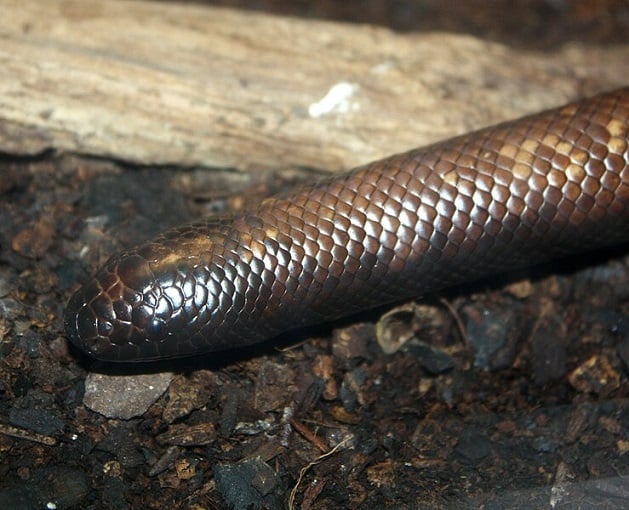
The Calabar python has no power to kill a human being. Instead, they have two interesting defensive strategies. The first is a tail deception, which begins when they press their head to the ground fearfully. A Calabar python’s tail looks extremely similar to the head, and by raising the tail and waving it rhythmically, they hope to draw attention away from their precious brain. The tail is also adorned with white stripes, designed to be even more eye-catching.
The second strategy is to coil up into a ball, and stuff its head into the centre to protect themselves. This is extremely similar to the ball python (which was how it gained its name). Calabar pythons might not build cities, they may not plant farms, and they might not understand mathematical equations, but they understand one thing: their brain is all-important.
Wild Calabar pythons have been reported to strike at aggressors very occasionally. Nevertheless, they’re very calm with humans in captivity. They can be handled to your heart’s content and stay peaceful. They don’t nip people’ arms as they attempt to pass them food. They don’t require several months (or years) of adjustment to human presence like the Amazon tree boa.
| 8 | Oak brown with tiny eyes |
The Calabar python is a cylindrical shape. Their body is even in thickness from head to tail, unlike the obese blood python. This shape is perfect for slithering through burrows. It’s rare for Calabar pythons to exceed 90cm. The longest of all time was 103cm, reported in 1966.
Their body scales are mostly a brown colour, with bright patches of red and yellow occasionally shining through. Their eyes are almost the exact same brown, with a tiny vertical pupil. The eyes are so small and blend in so strongly that they almost look like an extra scale. Their belly is a lighter grey-brown, and their scales are glossy and smooth, reflecting light well. Unlike many boas, the Calabar python lacks infrared-seeking heat pits, showing how isolated they are.
The name Calabar comes from a city in southeast Nigeria, which was once the centre of the palm oil industry. Situated along the Calabar river, it was an important 19th century trading hub, and one of the earliest points of contact for European colonists.
| 9 | Rated as “least concern” |
Spooky folklore hangs over this snake, including the Cameroonian belief that encounters cause women to become pregnant. The Efik tribe of Nigeria calls this snake iwod iba. In Pidgin English, it’s dubbed the “snake with two heads”, referencing the deceptive tail with its equal size to the skull.
Calabar pythons aren’t common in the international pet trade, but there’s moderate demand, and wild exports number 500-1500 each year. The top exporters are consistently Ghana and Togo. The greatest years were 1999 and 2000, each seeing nearly 2000 exported from Africa as a whole. However, this pales in comparison to the ball python, where 49,437 were exported from Togo in 2005 alone. Ball pythons are simply better understood as a pet, and therefore more popular for beginners. They’re also less shy by nature, and easier to catch.
With a large range across Africa, Calabar pythons are rated “least concern” by IUCN. The top threat is deforestation, but calabar pythons are more adaptable than some, and can cope with degraded semi-forest.
| 10 | Spiral-shaped teeth |
Another part of the tough skin study from earlier was more basic: stabbing the samples with a hypodermic needle. While the skin wasn’t invincible, it took far more force to puncture than other snakes.
Even the Calabar python’s teeth are unusual on the serpent evolutionary tree. The Calabar python was compared to five other snakes, including African rock pythons and bullsnakes. Those snakes had maxillary teeth curving backwards, designed for gripping prey, but the Calabar pythons only curved slightly. Its teeth went straight down, but were also spiralled, twisting in the centre.
Meanwhile, the length of the teeth was average, at 6.5mm. They were longer than the Rhombic Skaapsteker (3mm), but shorter than the rock python’s brutal chompers at 10.1mm. Their teeth were particularly gnarly looking, heavily striated. Calabar pythons are also missing two regular teeth: the palatopterygoids.
Another cool Calabar python fact is that their colours tell you their origin. Those with red spots usually originate from eastern parts of their empire like Cameroon, while yellow spotted pythons are found further west (Ghana, Benin, etc). The brown base always remains.

Thanks for sharing! I found a lifeless specimen just recently, which led to a fresh knowledge of the species.